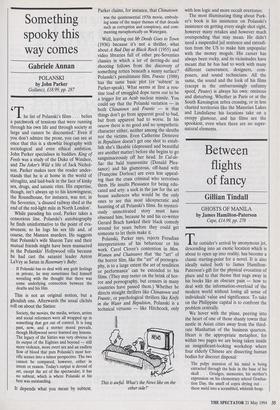Something spooky this way comes
Gabriele Annan
POLANSKI by John Parker Gollancz, .E.18.99, pp. 287 The list of Polanski's films . . . belies a patchwork of tensions that were running through his own life and through society at large and cannot be discounted.' Even if you don't admire the prose, you can see at once that this is a showbiz biography with sociological and even ethical ambition. John Parker specialises in baddies. King of Fools was a study of the Duke of Windsor, and The Joker's Wild a life of Jack Nichol- son. Parker makes sure the reader under- stands that he is at home in the world of ultraglitz, and laid-back in the face of kinky sex, drugs, and satanic rites. His expertise, though, isn't always up to his knowingness; the Roundhouse, for instance, was not, in the Seventies, 'a disused railway shed at the end of the red-light mile in North London'.
While parading his cool, Parker takes a censorious line. Polanski's autobiography he finds uninformative to the point of eva- siveness; so he logs his sex life and, of course, the Manson murders. He suggests that Polanski's wife Sharon Tate and their mutual friends might have been massacred in the Polanslcis' Hollywood villa because he had cast the satanist leader Anton LaVey as Satan in Rosemary's Baby:
If Polanski has to deal with any guilt feelings in private, he may sometimes find himself wrestling with the thought that there was some underlying connection between the deaths and his film.
This is not an original notion, but a ghoulish one. Afterwards the usual clichés roll on about the Sixties: Society, the movies, the media, writers, artists and social reformers were all wrapped up in something that got out of control. It is long past, now, and a sterner mood prevails, though Hollywood never learned any lessons. The legacy of the Sixties was very obvious in its output of the Eighties and beyond — still more violence, more overt sex and an endless flow of blood that puts Polanski's most hor- rific scenes into a minor perspective. The two cannot be compared, however, either in intent or reason. Today's output is devoid of art, except the art of the spectacular; it has no subtext, which is where Polanski at his best was outstanding.
It depends what you mean by subtext.
Parker claims, for instance, that Chinatown
was the quintessential 1970s movie, embody- ing some of the major themes of that decade such as corruption and conspiracy, and com- menting metaphorically on Watergate.
Well, leaving out Mr Deeds Goes to Town (1936) because it's not a thriller, what about A Bad Day at Black Rock (1955) and video libraries full of other pre-Seventies classics in which a lot of derring-do and shooting follows from the discovery of something rotten beneath a sunny surface? Polanski's penultimate film, Frantic (1988) has the same basic plot (or 'subtext' in Parker-speak). What seems at first a rou- tine load of smuggled dope turns out to be a trigger for an Arab nuclear missile. You could say that the Polanski variation — in both Chinatown and Frantic — is that things don't go from apparent good to bad, but from apparent bad to worse. In his oeuvre there is no good and no sympathetic character either, neither among the sleuths nor the victims. Even Catherine Deneuve in Repulsion doesn't get one shot to estab- lish she's likeable (depressed and beautiful are another matter) before she begins to go sanguinaceously off her head. In Cul-de- Sac the bald transvestite (Donald Plea- sance) and his glamorous, off-hand wife (Francoise Dorleac) are even less appeal- ing than the crass criminal who terrorises them. He insults Pleasance for being edu- cated and arty: a sock in the jaw for the art house audiences who would be the only ones to see this most idiosyncratic and haunting of all Polanski's films. Its mysteri- ously unmotivated story must have obsessed him, because he and his co-writer Gerard Brach hawked their black comedy around for years before they could get someone to let them make it.
Polanski, Parker says, rejects Freudian interpretations of his behaviour or his work. Carol Clover's contention in Men, Women and Chainsaws that 'the "art" of the horror film, like the "art" of pornogra- phy, is to a large extent the art of rendition or performance' can be extended to his films. (They may teeter on the brink of hor- ror and pornography, but censors in many countries have passed them.) Whether he directs straight thrillers like Chinatown and Frantic, or psychological thrillers like Knife in the Water and Repulsion, Polanski is a technical virtuoso — like Hitchcock, only This is awful. What's the News like on the other side?' with less logic and more occult overtones.
The most illuminating thing about Park- er's book is his insistence on Polanski's insistence on getting every single shot right, however many retakes and however much overspending that may mean. He didn't need a suspended jail sentence and extradi- tion from the US to make him unpopular with the money moguls. His career has always been rocky, and its vicissitudes have meant that he has had to work with many different cameramen, designers, com- posers, and sound technicians. All the same, the sound and the look of his films (except in the embarrassingly unfunny spoof, Pirates) is always his own: ominous and disturbing. Whether in Paris or at the South Kensington zebra crossing, or in less charted territories like the Masurian Lakes and Lindisfarne his locations take on a creepy glamour, and his films are the spookiest, even when there are no super- natural elements.




































































 Previous page
Previous page